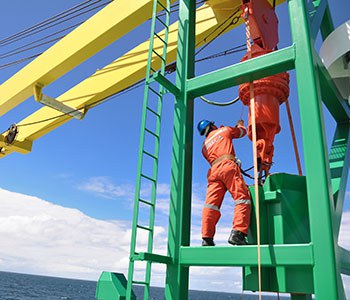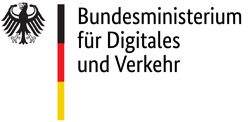Danger rate of the accident insurance now applies to maritime companies
 Every industry harbours different risks with varying degrees of danger. With its danger rates (Gefahrtarife), the BG Verkehr takes these varying risks into consideration when calculating contributions. This is relatively common practice in the accident insurance branch. However, until now, a different way of calculating the contributions still applied for the shipping industry, because a transitional period was in place after the former "See-BG" and the former "Berufsgenossenschaft für Fahrzeughaltungen" merged to become the BG Verkehr in 2010. As of 2022, the new danger rate applies for maritime companies as well, split into shore-based and ship-based branches and fishing enterprises funded by the States. There is good news, though: For most companies the changes will lead to lower contributions.
Every industry harbours different risks with varying degrees of danger. With its danger rates (Gefahrtarife), the BG Verkehr takes these varying risks into consideration when calculating contributions. This is relatively common practice in the accident insurance branch. However, until now, a different way of calculating the contributions still applied for the shipping industry, because a transitional period was in place after the former "See-BG" and the former "Berufsgenossenschaft für Fahrzeughaltungen" merged to become the BG Verkehr in 2010. As of 2022, the new danger rate applies for maritime companies as well, split into shore-based and ship-based branches and fishing enterprises funded by the States. There is good news, though: For most companies the changes will lead to lower contributions.
"Fictitious" danger rate numbers during trial period
To prepare for the ultimate transition, "fictitious" danger rate numbers (Gefahrtarifstellen) were introduced, which were then used by the maritime companies to assign their wage sums to during notification. These twelve "fictitious" danger rate numbers have now been summed up to three actual danger rate numbers; the previous separation into employees on shore and on board as well as State-funded fishing enterprises remains in place:
- The "fictitious" danger rate numbers 1 to 5 become danger rate number 880
- the "fictitious" danger rate numbers 6 to 11 become danger rate number 890.1
- the "fictitious" danger rate number 12 becomes danger rate number 890.2
So in the end, what does the employer have to pay in terms of contributions?
This formula serves to calculate the accident insurance contributions:
(wages x danger class x contribution base) : 1,000 = contribution
"Wages" are either average wages (Durchschnittsheuern) or for coastal fishermen and coastal seafarers with statutory insurance the average annual earnings (Durchschnittjahreseinkommen). These amounts can be found in the contribution overview on the website of the BG Verkehr. "Wages" also include the insurance sum of entrepreneurs who have a statutory or voluntary insurance.
The "danger class" (Gefahrklasse) of the respective danger rate reflects the level of risk of the occupational group. Accidents and occupational illnesses from six successive years are evaluated and summed up into a factor for the contribution calculation. Because the occupational risk of people working on shore is lower than those working at sea, the danger class is correspondingly lower as well: 1.71 in comparison to 10.14.
The "contribution base" (Beitragsfuß) is determined by the BG Verkehr on an annual basis. The advancement is anticipated to be based on a contribution base of 3.15.
| Danger rate number | Branch of trade | Danger class | |
|---|---|---|---|
| 880 | businesses and branches of maritime businesses on shore | 1.71 | |
| 890,1 | maritime businesses (members of crew of passenger, merchant, offshore, seaside excursion and ferry vessels, of towing, SAR and diving companies, employed in deep sea fishing, in sailing schools and on private yachts and canal pilots as well as those employed in high sea and coastal fishing without State funding) | 10.14 | |
| 890,2 | maritime businesses with State funding (high sea and coastal fishing as well as fishermen without vessel) | 10.14* The reduction of the contribution as State funding is not factored into the danger class but is part of the contribution calculation |
|
By the way: from 2022, the wages of employees will solely be transmitted to the BG Verkehr with the digital wage statements (LNdigital). The maritime company enters the respective danger rate number according to the job performed for the company. The BG Verkehr has developed a short film to explain the procedure (in German only).
Advancements and contribution notices
Like before, the contributions are paid in advancements as instalments. What is new is that the BG Verkehr determines the amount of the advancements and notifies you about them in advancement notices. This is also applicable to the insurance for entrepreneurs from 1st January 2022. These advancements allow the BG Verkehr to cover all of the insurance claims that come up throughout the year. The advancements are set off against the actual annual contribution in April the following year and considered in the final contribution notice.
Do you have any questions? The BG Verkehr has answered the most frequently asked questions about this on their website (in German only).
Good occupational safety is worth your while
The BG Verkehr wants to support their member companies in preventing accidents and occupational illnesses. That is why with the introduction of the danger rate, it is now possible to reduce the contribution by up to 5 % - for insurance contributions of entrepreneurs by up to 25 % - under the following conditions:
- The company or the insured person has been a member of the BG Verkehr for at least three complete contribution years,
- there has been an below-average accident claim by the respective company – this is determined annually by BG Verkehr – and
- the reduction does not fall below the minimum contribution of 62 Euros.
The percentage reduces in relation to the amount of occupational accidents a company reports. A higher than average number of cases in relation to the size of the company may even result in a surcharge, however. The size of the company is a decisive factor for the amount of accidents that can be covered with the basic contribution.
We have compiled an overview of all social security contributions and operands of 2022.

